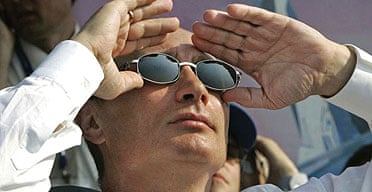Vladimir Putin announced ambitious plans to revive Russia's military power and restore its role as the world's leading producer of military aircraft yesterday.
Speaking at the opening of the largest airshow in Russia's post-Soviet history, the president said he was determined to make aircraft manufacture a national priority after decades of lagging behind the west.
The remarks follow his decision last week to resume long-range missions by strategic bomber aircraft capable of hitting the US with nuclear weapons. Patrols over the Atlantic, Pacific and Arctic began last week for the first time since 1992.
Presidential aides hinted yesterday that Russia could shortly resume the production of Tu-160 and Tu-95 strategic nuclear bombers, now that the aircraft are again flying "combat missions". The bombers would be used as a "means of strategic deterrence", a presidential aide, Alexander Burutin, told Interfax.
Mr Putin said Russia would also resume the large-scale manufacture of civilian planes. "Russia has a very important goal which is to retain leadership in the production of military equipment," he said.
The new emphasis on Russia's revived military prowess comes against a backdrop of deteriorating relations with the west. Mr Putin has denounced the US's missile defence plans in Europe, scrapped an agreement with Nato on conventional armed forces, and grabbed a large, if symbolic, chunk of the Arctic.
Yesterday a senior Russian general warned the Czech Republic it would be making a "big mistake" if it permitted the US to use its territory. Yuri Baluyevsky, Russia's military chief of staff, said Prague should hold off any final decision on the shield until after next year's US presidential elections.
"I do not exclude that a new administration in the United States will re-evaluate the current administration's decisions on missile defence," he said, after a meeting in Moscow with the Czech defence minister, Martin Bartak.
Speaking at yesterday's MAKS-2007 international airshow, Mr Putin said: "Russia, as a state that has acquired new economic capabilities, will continue to attach special importance to high technology and development."
Analysts, however, took issue with Mr Putin's claim that Russia was already the leading producer of military aircraft. However, they acknowledged that Russia had developed some impressive "technologies".
These include a new S-400 missile and aircraft interceptor system, similar but better than the US Patriot, and a lethal new supersonic cruise missile, the Meteorit-A.
"They have some very good kit," one industry observer said.
Russia also used yesterday's airshow - held at Zhukovsky, a former Soviet airbase on the leafy outskirts of Moscow - to show off its latest generation of jet fighters.
These include an upgraded Sukhoi jet, the SU-35, which has a new engines and a new radar system, and a revamped "vector thrust" MIG, the MIG 29-OVT. "They are good aircraft. The MIG can do a very lovely flip," the industry observer added.
One analyst said Mr Putin did not want confrontation with the west but was determined to restore Russia's strategic parity with the US.
"Russia wants balance. It wants a strategic balance with the US," Ivan Safranchuk, a Moscow-based expert on defence, told the Guardian.
"Russia wants to do this as cheaply as possible. But with the Bush administration withdrawing from arms control treaties, Russia is saying it is also ready to keep the balance at a high level of cost."
Asked about Russia's resumption of long-range bomber patrols, Mr Safranchuk said: "It's significant. For 15 years the political leadership was constraining the military on this. Now it isn't."
In the 1960s and 1970s the Soviet Union produced more civilian planes than any other country in the world apart from the United States.
After the collapse of communism, Russia's impoverished government drastically cut spending on its aircraft industry. Factories producing military planes fared better than those building civilian aircraft, mainly because of buoyant sales to India and China. But Russia started to fall behind the west in the design of advanced fighters and other military aircraft.
Mr Putin is now determined to make Russia the world's third-largest manufacturer of passenger jets - after the United States, with Boeing, and the European Union, with Airbus.
Russia's passenger airlines own about 2,500 ageing aircraft - of which just 100 are western-made models - although they fly one-third of all Russian passengers.
Last week Russian officials said they planned to build 4,500 civilian aircraft by 2025, while the Kremlin has pledged £125bn to boost the civilian industry.
As part of the plan to boost significantly Russia's civilian aircraft industry, a new state-controlled organisation, the United Aircraft Corporation, has been created.
It is led by Sergei Ivanov, Russia's hawkish first deputy prime minister, who sat next to Mr Putin during yesterday's airshow - and the leading candidate to succeed him after next year's presidential elections.
